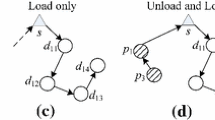Abstract
The Synchronized Pickup and Delivery Problem (SPDP) consists of finding a set of minimum-cost routes servicing user-specified transportation requests from pickup to delivery locations subject to pairing and precedence, capacity, time-window, and minimum and maximum time-lag constraints. The temporal constraints of the SPDP impose a complex scheduling problem for the service times at the customer locations which makes the efficient feasibility checking of routes intricate. We present different route feasibility tests for the SPDP and compare their practical runtime on a huge number of randomly generated routes. Furthermore, we generalize to the SPDP the concept of forward time slack, which has proven a versatile tool for feasibility testing of customer or request insertions into a given (feasible) route for many VRP variants.
Similar content being viewed by others

References
Barnhart C, Cohn AM, Johnson EL, Klabjan D, Nemhauser GL, Vance PH (2003) Airline crew scheduling. In: Hall RW (ed) Handbook of transportation science. Kluwer Academic Publishers, Norwell, pp 517–560
Bélanger N, Desaulniers G, Soumis F, Desrosiers J (2006) Periodic airline fleet assignment with time windows, spacing constraints, and time dependent revenues. Eur J Oper Res 175(3):1754–1766
Braekers K, Caris A, Janssens GK (2014) Exact and meta-heuristic approach for a general heterogeneous dial-a-ride problem with multiple depots. Transp Res Part B 67:166–186
Bredström D, Rönnqvist M (2008) Combined vehicle routing and scheduling with temporal precedence and synchronization constraints. Eur J Oper Res 191:19–29
Cherkassky BV, Georgiadis L, Goldberg AV, Tarjan RE, Werneck RF (2009) Shortest-path feasibility algorithms. J Exp Algorithmics 14:2.7–2.37
Cordeau JF, Laporte G (2003) A tabu search heuristic for the static multi-vehicle dial-a-ride problem. Transp Res Part B 37(6):579–594
Cordeau JF, Laporte G (2007) The dial-a-ride problem: models and algorithms. Ann Oper Res 153(1):29–46
Cormen TH, Leiserson CE, Rivest RL, Stein C (2001) Introduction to algorithms. MIT Press, Cambridge
Eveborn P, Flisberg P, Rönnqvist M (2006) Laps care—an operational system for staff planning of home care. Eur J Oper Res 171(3):962–976
Firat M, Woeginger GJ (2011) Analysis of the dial-a-ride problem of Hunsaker and Savelsbergh. Oper Res Lett 39(1):32–35
Gschwind T (2015) A comparison of column-generation approaches to the synchronized pickup and delivery problem. Eur J Oper Res 247(1):60–71
Gschwind T, Irnich S (2015) Effective handling of dynamic time windows and its application to solving the dial-a-ride problem. Transp Sci 49(2):335–354
Kovacs AA, Golden BL, Hartl RF, Parragh SN (2014) Vehicle routing problems in which consistency considerations are important: a survey. Networks 64(3):192–213
Lu Q, Dessouky MM (2006) A new insertion-based construction heuristic for solving the pickup and delivery problem with time windows. Eur J Oper Res 175(2):672–687
Masson R, Lehuédé F, Péton O (2013) Efficient feasibility testing for request insertion in the pickup and delivery problem with transfers. Oper Res Lett 41(3):211–215
Masson R, Lehuédé F, Péton O (2014) The dial-a-ride problem with transfers. Comput Oper Res 41:12–23
Pillac V, Guéret C, Medaglia AL (2012) A parallel matheuristic for the technician routing and scheduling problem. Optim Lett 7(7):1525–1535
Rasmussen MS, Justesen T, Dohn A, Larsen J (2012) The home care crew scheduling problem: preference-based visit clustering and temporal dependencies. Eur J Oper Res 219(3):598–610
Savelsbergh MWP (1992) The vehicle routing problem with time windows: minimizing route duration. INFORMS J Comput 4(2):146–154
Tang J, Kong Y, Lau H, Ip AWH (2010) A note on “efficient feasibility testing for dial-a-ride problems”. Oper Res Lett 38(5):405–407
Tarjan RE (1981) Shortest paths. Technical report, AT&T Bell Laboratories, Murray Hill, NJ
Acknowledgements
This research was partially funded by the Deutsche Forschungsgemeinschaft (DFG) under Grant No. IR 122/5-2.
Author information
Authors and Affiliations
Corresponding author
Additional information
Publisher's Note
Springer Nature remains neutral with regard to jurisdictional claims in published maps and institutional affiliations.
Electronic supplementary material
Below is the link to the electronic supplementary material.
Rights and permissions
About this article
Cite this article
Gschwind, T. Route feasibility testing and forward time slack for the Synchronized Pickup and Delivery Problem. OR Spectrum 41, 491–512 (2019). https://doi.org/10.1007/s00291-018-0544-0
Received:
Accepted:
Published:
Issue Date:
DOI: https://doi.org/10.1007/s00291-018-0544-0



